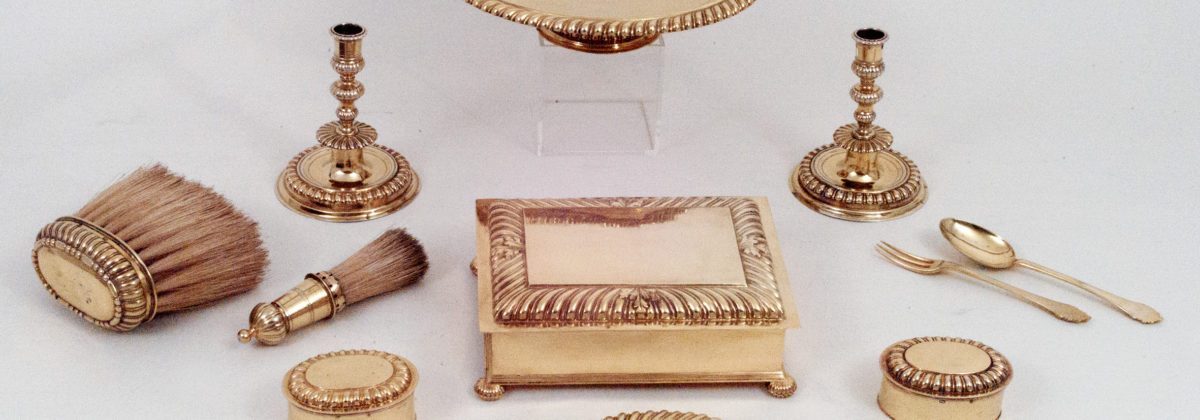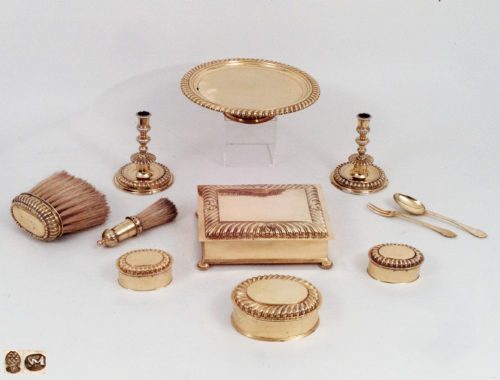Object Number: #187
Augsburg, 1711/15
Friedrich II Schwestermüller (ca. 1682-1752)
City hallmark: a „Pyr“ for Augsburg, period 1711/15 (Seling Nr. 1410)
Maker’s mark: „SM“ in round for Friedrich II Schwestermüller (Seling Nr. 2061e)
The parts of the toilette service silver-gilt are as following:
Large rectangular box, 21,5 cm x 16 cm weight 920 gr
Big oval box: 13,5 cm x 10 cm (5,1 x 3,9 in.); weight: 350 gr.
2 small boxes: 9 cm x 6,6 cm (3,5 x 2,4 in.); weight: each 150 gr.
Big brush: handle: 11 cm x 7,2 cm (4,3 x 2,7 in.); weight: 300 gr.
Small brush: l.: 8,5 cm (3,1 in.); with the brush bristles: 15 cm (5,9 in.); weight: 130 gr.
Cutlery set: W. together: 120 gr.; Spoon: l.: 17,7 cm (6,7 in.); Fork: L. 17 cm (6,6 in.)
Pair of Candlesticks: height: 14,5 cm (5,5 in.); weight: each c. 250 gr.
Tazza: Height: 7,5 cm (2,8 in.); Dm.: 27 cm (10,6 in.); weight: c. 630 gr.
Marks: the boxes are marked with clear hallmarks on the bottom and on the rim of the cover. All other objects are marked.
Detailed Information
Silver-gilt Eleven-Part Toilette Service
This set of objects, silver-gilt, originate from a toilette set, made in Augsburg, at the beginning of the eighteenth century. However, the main décor of gadroons as well as the round form of the boxes are following an earlier style for toilette sets dating rather back in the last quarter of the seventeenth century. This can be for instance observed in a group of objects, parts of a coffee and tea service, showed in the Maximilian museum in Augsburg (Augsburg 1698-1700, maker: J. U. Baur; museum’s number: 12146-12150).
The big box has an orthogonal form and is raised on four gadrooned bun feet. The cover is decorated with a gadroon-frieze and on every side, there is an acanthus leaf embossed. The cover is hinged so that the box can be still used.
The three boxes with a removable, slightly profiled cover have an oval form, typical for toilette set equipment of that time-period. The boxes and the brushes have as décor embossed gadroons, according to the style of the late baroque. The brushes, interesting collector’s pieces, keep obviously their original bristles. The big one was most probably used for the dry cleaning of clothes. The flat handles of the two-piece cutlery set are decorated with acanthus leaves. The spoon has an oval bowl and the fork is three-pronged.
The decoration of the pair of candlesticks is clear and presents elegant forms. The candlesticks are standing on a broad, vaulted and embossed foot, which is in a step-wise manner decorated. The foot is profiled and its main decorative motive is a gadroon frieze. A shaft with baluster and gadrooned decorative elements and nodes rises above the foot, while it is narrowing on a profiled ring. The spout has a baluster-shape and is also adorned with a pearl’s ring. The choice to create superimposed zones of fine, alternate decorative motifs, a ring between the foot and the shaft and nodes emphasises the excellent craftsmanship.
The matching tazza reproduces the same principal decorative motif of gadroons on the vaulted and profiled foot as well as on the rim.
All objects are kept in an excellent condition.
Toilette Sets in Historical Context
The French philosophe of the Enlightenment Monstesquieu had already commented the importance of a lady’s toilette at the beginning of the eighteenth century. According to him, a woman has attached a great importance to the morning preparations in front of the mirror: ”Le rôle d’une jolie femme est beaucoup plus grave qu’on ne le pense. Il n’y a rien de plus sérieux que ce qui se passe le matin à sa toilette. Un général d’armée n’emploie pas plus d’attention à placer sa droite ou son corps de réserve, qu’elle n’en met à poster une mouche, dont elle espère ou prévoit le succès.” (Montesquieu, as cited in Havard, Henry, L’art dans la maison : grammaire de l’ameublement, Paris : Rouveyre, 1887, vol. 2, p. 200).
Toilette services with a uniform style and homogeneous design were probably developed in France around the mid-seventeenth century. Until the end of this century, they were a kind of standard equipment for court ladies and noble men.
The first toilette services from Augsburg allow noticing a strong influence from French models. Since the end of seventeenth and the beginning of eighteenth century, the goldsmiths of Augsburg take a leading role in the production of toilette sets. Boxes, coffee- and teapots, cutlery set and other objects are often manufactured from the appropriate specialized makers.
The gilded toilette service was often offered as a marriage gift from a wealthy groom to his bride. Their role was the presentation in the bedroom or the boudoir and for the admiration of the viewer rather their use from the person who possessed them. Smaller, silver-coloured toilette set equipment was probably used for taking along on a journey.
For a complete toilette service from Augsburg, around 1695-1700, cf. Baumstark & Seling 1994: fig. 119/445. For a travel-toilette service, around 1741-1743, cf. Seling 1980: fig. 944/vol. II.
Maker
Friedrich II Schwestermüller, protestant, was a silver worker and born circa 1682. He was the son of the silver worker Friedrich I Schwestermüller. The family were one of the leading silversmith families in Augsburg. Friedrich II became a master maker circa 1713 and in the same year, he got married. He died in 1752.
Many works of Friedrich II Schwestermüller are kept in private and public collections.
Literature
Baumstark, R. & Seling, H. (Hrsg.), 1994, Silber und Gold: Augsburger Goldschmiedekunst für die Höfe Europas, Kat. Ausst. Bayerisches Nationalmuseum, Bd. II, München: Hirmer Verlag/Bayerisches Nationalmuseum.
Havard, Henry, L’art dans la maison : grammaire de l’ameublement, Paris : Rouveyre, 1887, vol. 2.
Heitmann, Bernhard, Die deutschen sogenannten Reise-Service und die Toiletten-Garnituren von 1680 bis zum Ende des Rokoko und ihre kulturgeschichtliche Bedeutung, Hamburg 1979 Diss., München, 1979.
Seling, H., 1980-2007, Die Augsburger Gold- und Silberschmiede 1529-1868, Bd. I-III, München: Beck Verlag.
Huber-Yüzgec, Christina, ‘Begleiter für alle Fälle: Toilettengarnituren und Reisenecessaires im Wandel der Zeit’ In: Wiese, Woflgang und Schröck-Schmidt, Wolfgand (Hrsg.), Das Stille Örtchen: Tabu und Reinlichkeit bey Hofe, Berlin-München: Deutscher Kunstverlag/Staatliche Schlösser und Gärten Baden-Württemberg, 2011.



